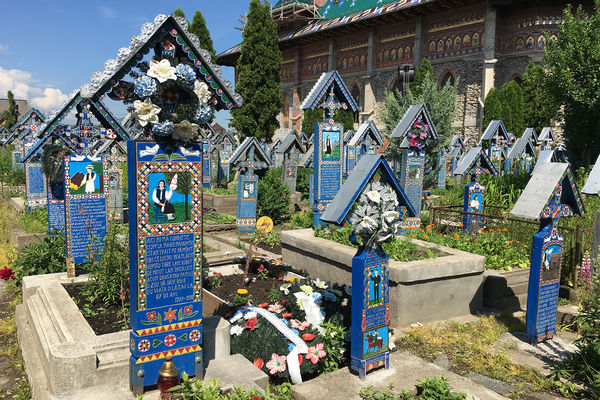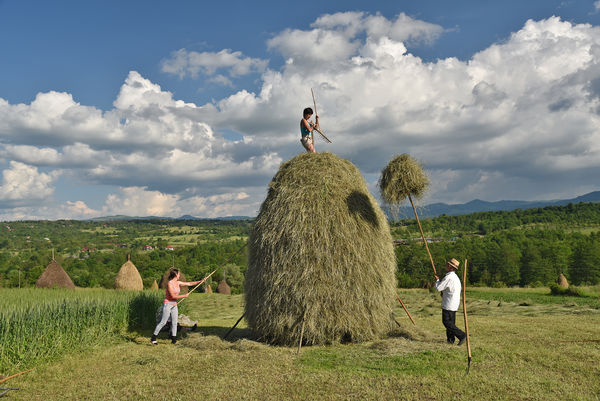Romania’s Countryside: A Land that Time Forgot
By Rick Steves

Romania is full of surprises and wonderful people. And as you leave the capital of Bucharest, it gets even better. In the Romanian countryside, the nation's unique history and traditional culture live on — vividly.
A hard-fought past is evident in the fortress-like churches scattered through the central region of Transylvania. In medieval times, big towns were well protected, but smaller villages were vulnerable to invaders. So industrious German settlers, imported by the local overlords to tame the wild frontier, fortified their churches.
Like medieval fortresses, these Saxon churches have beefy bastions, stout lookout towers, and narrow slits for raining arrows on enemies. Entire communities could take refuge inside — within wraparound defensive galleries.
Today most of Romania's ethnic Germans are gone, having emigrated in the late 19th century or fled to Germany after World War II. But their legacy has hardly disappeared. Stepping inside these churches feels like stepping into medieval Germany. Decoration is humble — pews are but simple benches — and Bible quotes are in German.
The whitewashed and ramshackle church of Viscri, hidden deep in the Transylvanian hills, is one of the oldest (c. 1100). Stepping inside, one of the first things you notice is that most of the pews don't have backs. That's to accommodate the starched dresses and long headdresses of traditional village women, who wanted to avoid creases in their best clothing. (The pews with backs were for the families of those who were from elsewhere — usually the minister and the teacher.)
Farther north, Romania's Maramureș region is Europe's most traditional corner. While it takes some effort to reach, Maramureș is well worth the effort for those who want to see a real, living open-air folk museum. It's a rolling, pastoral landscape speckled with haystacks.
Thanks to its rugged terrain and its great distance from Bucharest, Maramureș avoided communist farm collectivization — so people still tend their small family plots by hand. Horse carts seem to outnumber cows. Men in overalls and distinctive straw hats pile hay onto their wooden wagons. Women wear big, puffy skirts just above the knee, babushkas on their heads, and baskets laden with heavy goods on their backs. This region feels like a European version of Amish Country, where centuries-old ways endure. And the traditions on display aren't put on for the benefit of tourists — it's just the region's true lifestyle.
Wander through any village and peek into family compounds. Each one is marked with a huge, ceremonial wooden gateway — just big enough for a hay-loaded horse cart to trot through. The gates are carved with a whole iconography of local symbols: starburst (pagan sun worship), wolf teeth (protection), bull horns (masculinity), leaves (nature), and — most importantly — the "rope of life" motif, a helix-like design suggesting the continuity of life from generation to generation. Inside each courtyard, you'll usually see — in addition to the main house — a humble barn with a paddock, a garden patch, and an old-fashioned, hand-pulled well.
It's surprisingly common for locals to invite passing visitors inside. Many Maramureș residents are eager to show curious outsiders their humble homes. In Romania, meeting people often comes with a welcoming glass of the fruity, 100-proof Romanian moonshine called palincă. It's strong stuff — kind of like rubbing alcohol with a touch of plum.
One of the most memorable sights in this part of Romania is the Merry (as in "joyful") Cemetery. I've enjoyed a variety of graveyards throughout Europe, and I can safely say that the one in Maramureș is one of a kind. In 1935, a local woodcarver — inspired by a long-forgotten tradition — began filling this cemetery with a forest of vivid memorials. Each one comes with a whimsical poem and a painting of the departed doing something he or she loved.
Although the cemetery is dubbed "merry," many of the memorial poems are downright morose. Tales of young lives cut short by tragic accidents, warriors mowed down in the prime of life, and people who simply never found happiness are a reminder that death, and life, are often profoundly sorrowful. Even if you can't read the poems, the images speak volumes: weaver … loved bikes … television repairman … soldier … hit by a car … struck by lightning … nagging mother-in-law.
But each memorial is a poignant celebration of each individual's life, a chronicle of village history, and an irreverent raspberry in the face of death. And it's all painted a cheery blue to match the heavens where the souls are headed.
Traveling in the Romanian countryside, you'll find evocative reminders of the past and time-warp lifestyles, seemingly oblivious to the "normal" modern world that envelops us elsewhere. More than any place I've found in Europe, this is a place where, when you slow down and let adventures unfold, they will. In Romania, you'll find that rather than famous sights, it's the happy and unpredictable serendipity that leaves you with lifelong memories as souvenirs.

